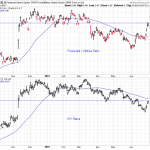Wal-Mart’s problems may well reflect deeper issues in the U.S. economy.

The giant retailer announced Wednesday that profits could drop as much a 12% in the next year. It’s stock plummeted 10% on the news. Company officials also warned they now expect sales growth for the current fiscal year to be flat. In February, the company predicted 1 to 2% growth.
According to the Wall Street Journal, the cost of recent wage increases is weighting heavily on the company’s profit margin:
For the first time Wednesday, Wal-Mart detailed next year’s costs of raising wages for its more than one million store workers. In April, the company raised the minimum hourly wage it pays those employees to $9, and will raise that to $10 for most in February. The higher pay will add $1.2 billion to costs this year and another $1.5 billion next year, the retailer said.”
But Wal-Mart’s problems aren’t just increasing costs. Sales revenue is also expected to drop, according to a Reuters report.
Wal-Mart Stores said current fiscal full-year sales would be flat due to the stronger-than-anticipated impact of the dollar. It had previously forecast net sales growth of 1-2 percent for the current fiscal year ending January.”
The mainstream financial media generally spun Wal-Mart’s problems as purely Wal-Mart problems. But as Peter Schiff pointed out in his podcast, the giant retailer may well be the “canary in the coal mine,” warning of more generalized economic issues.
In fact, overall US retail sales came in weaker than expected in September. Even the Wall Street Journal deemed them a “disappointment.”
Retail sales rose a seasonally adjusted 0.1% in September from August, the Commerce Department said Wednesday. Economists had expected a rise in September of 0.2%. The increase was largely due to a 1.8% month-over-month increase in auto sales. Excluding motor vehicles and parts, sales at other retailers were down 0.3% in September.”














Leave A Comment